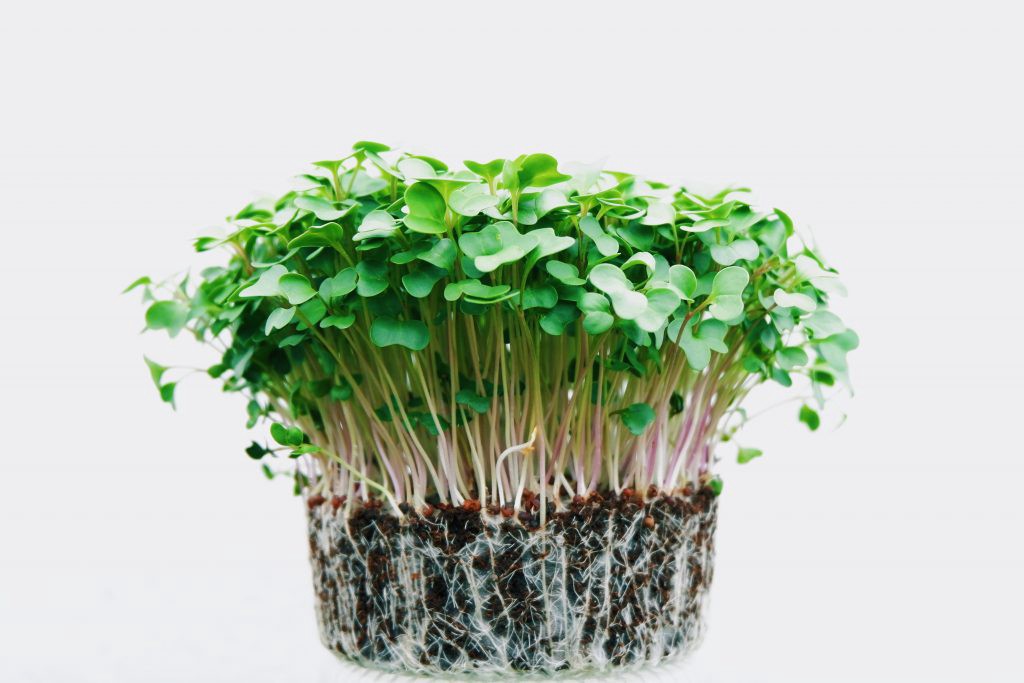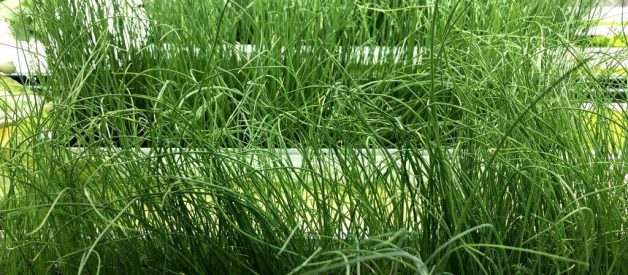Once used as merely a garnish, microgreens have become a staple in the culinary world for adding a blast of healthy flavor.
It?s quick and easy to grow these baby plants. Plus, they?re multifunctional. Use them for their health benefits or to make some extra cash.
In this article, we?ll explain how and why you should start growing microgreens at home.
What are microgreens?
Microgreens are baby plants somewhere between the sprout and baby green phases that are more flavorful and nutrient-rich than their fully grown counterparts.
These fledgling crops can be grown from a variety of seeds. Anything from broccoli to radish to quinoa to melons can produce microgreens.
Microgreens differ from sprouts and baby greens in a few ways.
For one thing, unlike sprouts, microgreens have leaves. Sprouts are merely germinated seeds, the first stage of plant growth after planting.
Sprouts don?t even really need light or nutrition to grow. Plus, they?re usually harvested from the root, while microgreens are harvested at the stem.

Microgreens are a result of the cotyledon stage, which usually occurs in about 10 to 14 days. At this stage, leaves begin to appear and the plants are at their most flavorful and nutritional.
Baby greens, on the other hand, are a little more mature. They are harvested shortly before the plant is considered fully mature.
Microgreens can contain 40 times as many vital nutrients compared to fully mature produce.
They also have more intense flavor than sprouts, baby greens, and mature vegetables due to their high concentration of nutrients. So, not only are microgreens healthier, but they taste better too!
Why should you grow microgreens?
Growing a microgreen garden can be an excellent way to improve your own health and make money.
Farming your own produce is rewarding on its own. Knowing exactly what went into your vegetables somehow makes the food taste so much better, and microgreens are an extremely healthy option.
A 2016 study from the Agricultural Research Service showed that red cabbage microgreens helped mice on high fat diets lose weight and lower their cholesterol levels better than mature cabbage. While mice are certainly not the same as humans, the potential for the same improvements is present for us.
Red cabbage microgreens were also shown to have 260 times more beta carotene than mature cabbages in a 2018 study called The Science Behind Microgreens as an Exciting New Food for the 21st Century.
Beta carotene is an organic pigment that the human body converts into vitamin a, which is essential for healthy vision and immune systems.
Wheatgrass, a popular shoot in juices and smoothies, has even been found to have the potential to help kill cancer cells, according to a 2017 study published in the Journal of Clinical and Diagnostic Research.
Microgreens can also bring in a profit.
These crops are quick to grow and require very little space and resources, making them relatively inexpensive and easy to produce.
Plus, they can fetch a high price, selling for about $25 per pound. A 10-by-20-inch tray typically produces about five to six ounces of microgreens, so doing the bare minimum with only three trays and harvesting every two weeks you end up with about $50 in your pocket every month.
Imagine how much you could make with more trays!

Sell your produce at farmers? markets or to local restaurants, vendors, and wholesale distributors.
Start by researching local markets to find a few vendors who might be willing to sell your products. If you approach them with some fresh samples, they might buy your product!
Alternatively, research wholesale distributors in your area. Distributors will find places to sell your products for you so that you don?t have to.
Distributors and local restaurants work best if you have a lot of produce to sell.
Focus on finding restaurants that specialize in creating seasonal menus using locally farmed vegetables. Approach chefs directly by setting up an appointment and maintain a rapport with them to ensure consistent business.
?Try to establish an on-going working relationship with the restaurant, either as supplier for a specified commodity or as their ?restaurant garden? to supply a wide range of their needs,? recommends Eric Gibson in his book Sell What You Sow!
If you?d prefer a more hands-on approach to selling to customers, set up your own booth at a farmers? market.
Research busy markets in your area and learn how you can start selling. Some farmers? markets can cost a few hundred dollars for a season while others can charge for weekly attendance, so try to stay within your budget.
How do you grow microgreens?
Microgreen crops are simple to plant and only have to grow for a couple of weeks to be ready for harvest.
Microgreens are best grown indoors. They don?t need much sunlight and the outdoors makes them susceptible to pests and disease.
Finding seeds to grow microgreens is easy. You can order seeds online or purchase them at a gardening store.
Special microgreen seeds are not required. Feel free to use seeds you?d normally use for a fully mature plant.
To decide what type of greens you?d like to grow, research what is popular or hard to find in your area. Or simply plant the seeds of your favorite vegetables.
Look into care instructions for the specific species you choose to produce the best yield.
Some seeds like sunflower or cress need to be soaked in water for 24 hours before being sowed.
Spread the seeds evenly on the surface of a nutrient rich and moisture retaining soil. For smaller seeds, consider using a saltshaker to get an even spread.
Try not to over sow. A standard 10-by-20-inch tray should contain up to eight ounces of seeds for a dense production.
Most microgreens grow stronger if they face harsh conditions while germinating. Cover your sowed seeds with the bottom of another tray and add some weight for a few days. Remove the tray and weight once the seeds have sprouted.
Depending on the species, allow your microgreens to grow, watering as needed for about 10 days. Harvest once the shoots have grown leaves and stand three to six inches tall.
Be sure to wash your produce thoroughly before consuming or selling it.
Which microgreens should you grow?
With so many options to choose from, it can be hard to pick which seeds to start with. Try experimenting with a few different plants to figure out what you like to grow.
Popular microgreens include sunflowers, radishes, and wheatgrass.
Sunflower microgreens are the most popular microgreens. They are rich in protein and vitamin B and add a slightly sweet taste to any dish.
Black oil seeds are recommended for strong flavor and healthy plants.
Radish microgreens have the same crisp, spicy flavor that mature radishes are famous for. Opal and green daikon varieties have high concentrations of vitamin E, which helps slow cell damage.
Radish crops are considered the fastest growing microgreen.
Wheatgrass is the microgreen version of common wheat. It?s also the gift that keeps on giving as shoots will continue to grow after harvest.
Wheatgrass, commonly labelled a superfood, is most popularly prepared as a juice for its high concentration of nutrients.

Harvested microgreens can be used for just about anything. Experiment by putting microgreens in pasta sauce, adding them to salad for extra flavor, or blending them in a smoothie for added nutrients.
In this article, we learned about microgreens, their health benefits, and how to start growing and selling them.
With this information it should be easy to start your own microgreen farm. Take a look at our hydroponic grow systems built in repurposed shipping containers to get planting!
Visit our website or give us a call at 602?753?3469 for more information.


